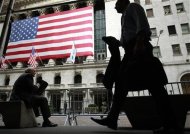RELATED CONTENT
 View PhotoMorning commuters are seen outside the New York Stock Exchange, July 30, 2012. REUTERS/Brendan McDermid
View PhotoMorning commuters are seen outside the New York Stock Exchange, July 30, 2012. REUTERS/Brendan McDermid
By Edward Krudy
NEW YORK (Reuters) - It's another one of those moments that always follow a big move in the stock market: Either you're a believer - or you're not. Right now, the market has its fair share of both.
The S&P 500 is up 12 percent so far this year. Through July, it had its best first seven months since 2003 and its second- best seven-month run since 1998. That sounds like a bull market.
But there is clearly a disconnect between the way markets have performed and the high level of caution among many investors. That is mainly due to the perception that things have the potential to go horribly wrong - incredibly fast.
The danger for investors is that they focus too much on the potential risks, such as the break-up of the euro zone, and end up getting left on the sidelines when markets move higher as they have done since the start of June, said Doug Cote, chief market strategist at ING Investment Management, in New York.
"We are in a bull market," he said. "The mistake investors have made is too much attention on global risk, and not enough attention on fundamentals that are very resilient."
Cote believes that record high aggregate earnings for S&P 500 companies this year and signs of improvement in the labor market mean investors should be taking on more risk rather than fretting about the dangers stemming from Europe's debt crisis.
NO EASY CHOICES
But for the more equivocal souls, the market is presenting a difficult dilemma, and strong convictions either way are elusive.
David Joy, chief market strategist at Ameriprise Financial in Boston, says it's an uncomfortable time for many investors, who are caught between missing a rally and getting blindsided by some nasty event that sends markets into a tailspin.
"It's a dilemma that is uncomfortable to watch and to function in," said Joy, who helps oversee $571 billion in assets. "It's one of those markets where you're running a big risk being out."
Joy says the rally is being driven by the hope of more "easy money" policies from central banks in the United States, Europe and China.
He has had doubts about the strength of the economy for many months. At the same time, he has been worried by the recent spate of cautious outlooks from corporate managers. But he also knows what investors ignore at their peril: "You can't fight the Fed."
"I don't like the fundamentals, I don't like what I'm seeing economically, I don't like what I'm seeing in terms of earnings forecasts going forward, but I recognize that central banks can trump all of those things," Joy said. "You may be right on the fundamentals, but wrong on the price action of the market."
Both the European Central Bank and the Federal Reserve are due to meet during the first half of September. Investors are hoping the ECB will buy bonds of troubled European nations in a bid to ease the debt crisis.
CAUTION CUTS BOTH WAYS
But Joy is also cautious about what many are describing as early signs of stabilization in the U.S. economy after a soft patch earlier in the spring and summer.
The July nonfarm payrolls report, which showed U.S. employers had done the most hiring in five months, is not enough to convince investors like Joy who want to see more confirmation before unwinding their defensive stance and getting more aggressive.
That cautious view that led him to cut his bond-equity allocation and lean more toward defensive areas of the stock market, such as consumer staples, healthcare and utilities, helps explain an oddity of the market's rally since June.
Much of the money heading into U.S. equity markets over the last two months has been heading into defensive sectors, some of it in a flight to safety from overseas markets, especially Europe.
Of two classically defensive sectors - utilities and telecoms - the utilities sector is trading at a 24 percent premium to the S&P 500, compared with an average 5 percent discount over the last 10 years, while the telecom sector is trading at a 50 percent premium compared with the usual 5 percent, according to data cited by UBS Wealth Management.
For Jeremy Zirin, UBS Wealth Management's New York-based head of U.S. equities and chief U.S. equity strategist, that is both a red flag highlighting the market's misgivings and a potential opportunity, should that differential start to narrow.
"We have a bit of a pro-cyclical tilt in our sector strategy within U.S. equity markets, largely because the market seems to be positioned so defensively," Zirin said. "We have seen this flood of flows going into defensive safe havens with high yield, and we just think they are very highly priced.
"Cyclical sectors seem to be pricing in something of a more dire economic scenario than we envision," he said. "Cyclical sectors are trading at a nearly two-decade valuation low relative to defensive sectors."
Of course, the market could also be setting itself up for a fall. Betting on what central bankers will and won't do is a risky game.
"Investors who have been hopeful that policymakers will take stronger action through this entire sovereign debt crisis have been consistently disappointed," Zirin said. "The notion that someone with very deep pockets will come along and pay the bills without conditionality is likely to be a foolish one."
That is why many are still erring on the side of caution.
Harris Private Bank in Chicago has been using the U.S. stock market's rally to cut its remaining exposure to stock markets in developed European economies.
They have repatriated the money to the United Stated where they have invested in U.S. equity positions, cautiously hedged with options. They now have higher-than-normal exposure to both U.S. and emerging market equities.
"We are certainly well overexposed to dollar assets," said Harris Private Bank's chief investment officer Jack Ablin. "We are sanguine on equities in general, but still very concerned about the outcomes in Europe."
(Wall St Week Ahead runs every Friday. Comments or questions on this column can be emailed to: edward.krudy(at)thomsonreuters.com)
(Editing by Jan Paschal)


No comments:
Post a Comment